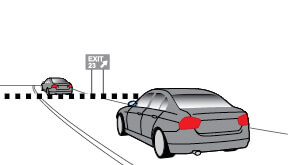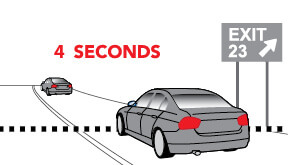6- Looking Ahead
Goal: Teach your teen to develop defensive driving techniques and higher-level visual and anticipatory driving skills before moving on to more complex driving situations. In order to avoid last-second reactions and spot potential hazards, have your teen always look 12–15 seconds down the road. When they are looking far enough ahead, they will be able to spot hazards early and be well prepared to react to them.
Location: Start on a quiet neighborhood street. Out of respect for our neighbors, please do not use official state road test courses for practice. Move onto a road with light traffic when your teen is ready.
Lesson one – SIPDE system
Teach your teen the SIPDE system, a simple system to help new drivers recognize, anticipate
and avoid risks before they turn into problems. SIPDE stands for:
Scan continually for immediate and potential hazards.
Identify potential risks, like oncoming vehicles, pedestrians, obstacles, or intersections.
Predict when and where there will be a conflict or problem.
Decide on the best course of action.
Execute that action.
Have your teen use commentary driving as they practice the SIPDE system. As they drive, ask them to verbally describe their thoughts and actions while they scan the area in order to identify potential risks they see, predict problems these risks could cause, decide what to do to avoid these problems, and then execute the maneuver.
Lesson two – stopping-distance rule
Teach your teen the stopping-distance rule, for the safest distance to stop behind another vehicle. When your vehicle stops, you should be far enough away from the car in front of you that you can see where its tires make contact with the ground. Any closer is too close.
Lesson three – four-second rule
Teach your teen the four-second rule for the appropriate following distance when driving behind other vehicles in clear, dry weather. The four-second rule is an important safety measure designed to give drivers enough time to safely steer or brake to avoid problems that occur in front of them on the road. Additional time is beneficial in bad weather, at night or otherwise to stop safely.
- Start counting when the rear bumper of the vehicle in front of you passes an object.
- Count “one thousand ONE, one thousand TWO, one thousand THREE, one thousand FOUR.”
- Your front bumper should not pass that same object before you’ve reached “four.”
Have your teen practice the four-second rule at least 10–12 times, counting out loud to check whether their following distance is appropriate.


Your front bumper should not pass before you’ve reached “four.”